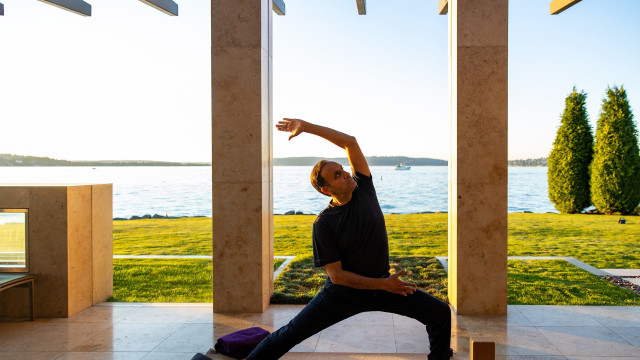Is Mindfulness a Leadership Trait?

Meditation and mindfulness practices have been shown to cultivate emotional intelligence — a primary leadership skill for anyone overseeing a team of people. Brands from health care to technology have adopted mindfulness techniques to help leaders engage employees and transform cultures. When leaders are able to respond to challenges skillfully and calmly in the workplace, they can inspire others to connect and collaborate to solve problems.
A recent survey from HR Sentiment, The Future Workplace, found that 68% of senior HR leaders rated employee wellbeing and mental health as a top priority. In response, the global corporate wellness market is now estimated to reach $90.4 billion by the year 2026, and mindfulness in leadership is becoming important as a leadership skill.
Meditation & Mindfulness in the Workforce
Market Research reports that 22% of employers in 2018 were planning to offer mindfulness training in the workplace. General Mills, the popular U.S.-based food company, has been offering mindfulness programs to staff since 2006. Google recently unveiled a series of on-campus enclosed environments, offering employees respite from work to experience calm.
In recent years, these companies recognized both the need for workplace wellbeing, and the power of mindfulness. “Understanding the emotions of others is important in order to respond appropriately and involve all parties in achievement of goals and to meet the goals of an organization,” says meditation teacher Gayle Van Gils in her course, Compassionate Leadership.
Mindfulness tools can help increase our attention to others by reducing our own stress and cultivating awareness — an easy answer to the question of why you should meditate. It’s through conscious awareness that we can begin to develop empathy, benefiting both leaders and employees alike. “Leading with emotional awareness is how we engage in our own lives and help others,” says Van Gils.
The Basics of Mindfulness
Mindfulness practice calls our attention to the present moment, allowing us to regain focus and clarity when distracted or disrupted. It starts with awareness of the body, and moves into awareness of thoughts and feelings. And while mindfulness starts with cultivating awareness through meditation, it also incorporates breathing techniques that can directly impact our stress response.
When we slow down and become mindful of what’s happening around us, we can into a present state of mind and focus on the here and now, and avoid the trap of getting stuck ruminating on the past or worrying about the future. Mindfulness-based therapies (MBT) are especially effective for reducing anxiety, depression, and improving our management of stress.
Pro tip: Check out this everyday mindfulness collection of classes, music, and meditations for everyday mindfulness practices.
Mindfulness can influence our mind and body in physical ways, as well, literally changing our brain. A 2022 meta-analysis from Roundglass Research Lead David Vago, Ph.D., and colleagues published in the journal, “Scientific Reports,” demonstrated that mindfulness meditation practices consistently modify and strengthen neural pathways in the brain, suggesting improved internal and external regulation of attention between the body and the environment. These research studies demonstrate that meditation clearly has benefits.
What Is a Mindful Leader?
A mindful leader is a figure head that can direct and inspire others in the workplace through greater emotional intelligence and strong leadership skills. When someone in a senior position can lead with emotional awareness, they can better engage and help others. “If you can lead your own life with emotional awareness, you have a quality that makes you a good leader and communicator with others,” says Van Gils.
It’s not uncommon for CEOs, leaders, and managers to adopt mindfulness training. Adding meditation and mindfulness practices to the workplace is becoming more widespread. It is through the lens of mindfulness that leaders can better understand the importance of emotional awareness and regulation in the workplace. When leaders show up emotionally ready and aware, they can cultivate empathy and genuinely engage with curiosity and compassion.
Pro tip: Try the S.T.O.P practice next time you’re feeling emotionally hijacked.
3 Mindfulness Tips for Your Professional Toolkit
- Remain unbiased — Developing a neutral viewpoint allows leaders to hear and solve any issues that arise in the workplace. This broad perspective leaves space to respond from a position of empathy, and allows the best choices for the business to become clear. When leaders can stay open and see a challenge from all sides, they can lean into their curious nature for problem-solving.
- Acknowledge the wins — People want to feel like they matter. Whether personal or professional, when leaders cultivate gratitude in the workplace, it creates goodwill across teams and may even inspire others to follow suit. Acknowledge achieved KPIs, and celebrate any wins, big or small. When leaders ingratiate themselves to employees, workers are more inclined to show up and more fully support business initiatives.
- Cultivate curiosity — Open your mind and get curious so you can inspire imagination, empathy, and engagement. When leaders show up with open minds and hearts, employees may also feel safe to dream big.
Pro tip: Try this mini meditation and learn to lead from the heart.
Bringing Mindfulness to Work
Mindfulness in leadership affects an employee’s experience wholistically, by building a library of services and tools that ultimately help workers do their best work. According to a Harvard Business Review report, while 81% of business executives strongly agree that highly engaged employees perform better and are more productive than employees with average or low engagement. Employee engagement can be thought of as the result of mindful leadership — the more employees are present, focused, and energized, the better the work they produce.
To develop mindfulness as a leadership skill, consider taking a course, or starting with a simple mindfulness meditation. Approach meditation like an experiment, and find what works for you. Notice how each experience affects your body and mind, and build a flexible routine. Try introducing mindfulness practices in the workspace, inviting in team members to take a few moments of stillness before meetings or to kick off the work week.
Pro tip: This 30-second meditation can kick-start a regular meditation practice.
“To be in service is to lead from the perspective of “We” instead of “Me,”” says Van Gils. Compassionate action, or the ability to regulate emotions and not react in fight-flight-freeze, is what leaders can lean into, pulling together the pillars of mindfulness. Nurturing self-awareness, emotional intelligence, facing difficult interpersonal problems, addressing problems with empathy, and doing so without emotional reaction allows workplace leaders to truly serve those they work with. As the workplace continues to evolve, a wholistic brand of leadership is required — one that focuses on where you show up and how you show up, and the mindset needed to drive work forward.
We have a library of practices to help strengthen your meditation practice. Download the Roundglass app to find what's right for you.
Key Takeaways:
- Mindful leaders introduce calm, and inspire to others to collaborate and solve problems.
- When leaders show up emotionally ready and aware, they can genuinely engage with curiosity and compassion.
- Mindfulness tools can help increase attention by reducing stress and cultivating awareness.
- A mindfulness practice nurtures attention to the present moment, allowing leaders to regain focus and clarity.








